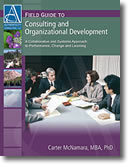Founder’s Syndrome: How Corporations Suffer — and Can Recover
© Copyright 1995 Carter McNamara, MBA, PhD, Authenticity Consulting, LLC.
Adapted from the Field Guide to Leadership and Supervision in Business
and Field Guide to Leadership and Supervision for Nonprofit Staff
and Field Guide to Developing, Operating and Restoring Your Nonprofit Board.
Also consider
Introduction
This syndrome occurs when, rather than working toward its overall mission, the organization operates primarily according to the personality of a prominent person in the organization, for example, the founder, board chair/president, chief executive, etc. The syndrome is primarily an organizational problem — not primarily a problem of the person in the prominent position. This manual happens to focus on the situation where the organization works according to the personality of the founding chief executive. However, it could be in regard to, for example, a Board Chair who came along after the founder had left — the symptoms and actions to recover are essentially the same.
Table of Contents
Preface
Founders’ Syndrome: During Tenure of Founder
- A Typical Problem in Small Organizations
- Some Troublesome Traits Among Founders
- Typical Traits of Well-Developed Leaders
- Basic Principles in Developing Leadership
- Actions Boards Must Take
- Actions Founders Must Take
- Actions Staff Might Take
- Summary
Transitioning to a New Chief Executive
- Founder’s Syndrome: When New Chief Executive Replaces Founder
- Typical Symptoms
- Actions Boards Must Take
- Actions New Chief Executive Must Take Before Taking the Job
- Actions New Chief Executive Must Take After Taking the Job
- What if Founder Left the Organization in a Mess?
Appendix A – Procedure for Transitioning to a New Chief Executive
Other Related Online Articles
Preface
I learned a great deal about Founders’ Syndrome while facilitating various Leaders Circles meetings, starting in 1995. A Leaders Circle is a peer-based development program that I developed in 1995, which includes five to seven members who meet regularly to share coaching for ongoing support, problem solving and networking. (Leaders Circles is a registered trademark of MAP for Nonprofits in St. Paul, Minnesota.)
I used the phrase Founders’ Syndrome to describe the set of symptoms that I noticed among struggling founders of organizations. I’m not sure where I got the phrase, whether I noticed it in literature or it came to my mind. At the time, it seemed like an appropriate phrase, but I’ve since come to regret using it because it’s an organizational problem, not a personal problem.
I wish to thank Joan Wells, Executive Director of Resources and Counseling for the Arts in St. Paul, Minnesota. She suggested that the syndrome be the focus of a workshop held by her organization. I developed and organized many of the ideas for this booklet in preparation for the workshop. I also wish to thank Joan for contributing the section “What New Chief Executives Must Do Before Taking Job”, as well as contributing several other key insights throughout this booklet. I also with to thank the editors of the Nonprofit World who allowed me to continue to share portions of this booklet that were also published in my article in their November-December 1998 issue.
This booklet may be freely distributed. The booklet should not be used for commercial purposes, i.e., to generate profits without the express written consent of the author. The booklet is available on the World Wide Web at https://staging.management.org/misc/founders.htm
Founders’ Syndrome: During Tenure of Founder
A Typical Problem Among Small Organizations
· To continue to meet the needs of their customers, organizations must evolve through a particular life-cycle change.
· This change is from typically entrepreneurial, seat-of-the-pants growth to well-planned and managed development.
· However, this development cannot occur without first establishing a stable administrative infrastructure.
· Developing this infrastructure often requires a change in the nature of the founder’s leadership from that of a highly reactive, individualistic style to a more proactive, consensus-oriented style.
· Many founders cannot make this transition. As a result, the organization remains managed, not in a manner that provides reliable services to customers, but according to the personality of the founder.
· Often, the organization experiences the same problems over and over again. For example, plans are not implemented. Money keeps running out. Board and staff members quickly come and go. The organization struggles from one crisis to another. No one really seems to know what’s going on. People become afraid of the founder.
· Founders Syndrome is no one’s fault — no founder sets out to damage their organization. Besides, the syndrome rarely takes hold without numerous members of the Board and staff exhibiting symptoms of the syndrome.
· Eventually, stakeholders confront the founder about the organization’s recurring problems (if the organization is a nonprofit, funders often will confront the chief executive or board). Often, the founder becomes increasingly anxious and defensive, and soon resorts to blaming Board members and staff (nonprofits also blame funders). Without ongoing coaching and support, it’s likely that the founder will be replaced, or even worse, the organization will fold.
· There are actions that founders and Board members can take to avoid these tragic outcomes. Start simple, but start.
Some Troublesome Traits Among Founders
Founders are dynamic, driven, and decisive. They carry clear vision of what their organization can be. They know their customer’s needs and are passionate about meeting those needs. Often these traits are strong assets for getting the new organization off the ground. However, other traits of founders too often become major liabilities. For example, founders often:
- Are highly skeptical about planning, policies, and procedures. They claim “they’re overhead and just bog me down”. They often believe they’ve found a new way to get things done.
- Make reactive, crisis-driven decisions with little input from others. React to most problems with the lament “if only I had more money.”
- In the case of nonprofits, executive directors attend mostly to fundraising and generating new ideas for services.
- Hand-pick their Board members and staff. See these people as working for the founder as much as working for the organization’s mission.
- Attract Board members through founder’s dynamic, often charismatic personality — not through focus on organization’s mission.
- Count on whomever seems most loyal and accessible, and motivate by fear and guilt, often without realizing it.
- Hold occasional staff meetings to report crises and rally the troops.
- In the case of nonprofits, executive directors usually see their Boards mostly as a source for fundraising, and work to remove Board members who disagrees with founder.
- Have a very difficult time letting go of the strategies that worked to quickly grow the organization, despite evidence that the organization can no longer absorb this rapid growth without major changes.
- Ultimately, Founders Syndrome sets in because the organization becomes dependent, not on the systems and structures of the organization, but on the unique style of the leader — whether the leader is consistently decisive or consistently indecisive.
Typical Traits of Well-Developed Leaders
Leaders of lasting, well-developed organizations have experienced numerous changes, and managed to
develop their organizations and themselves along the way. Developed leaders:
- Appreciate plans and budgets as guidelines, and realize these ultimately make their organizations more responsive to the needs of their customers.
- Make proactive decisions based on mission and affordability.
- Make staffing decisions based on responsibilities, training, and capabilities.
- Value Board and staff members for their strong expertise and feedback.
- Sustain strong credibility among customers and service providers.
Basic Principles in Developing Leadership
Eventually, most founders realize they must change the way they operate. Many go on to develop their leadership style to the next level. First, they realize they must change from within. They:
- Understand that the recurring problems are not their fault — they’re doing the best they can.
- Are willing to ask for and accept help.
- Communicate often and honestly (this is sometimes difficult for crisis-driven, “heroic” leaders).
- Engage in stress management, especially forms not related to their jobs.
- Are patient with themselves, their Boards, and staff.
- Regularly take time to reflect and learn, particularly about their value in service to others.
Actions Boards Must Take
Making this change in leadership style is often confusing, lonely, and stressful for the founder. The Board can be the founder’s greatest help.
1. Understand and take full responsibility for the role of Board member. Insist on focused Board training to review the roles and responsibilities of a governing Board. Undertake a yearly self-evaluation of the Board to ensure it is operating effectively.
2. Once a year, conduct a key risk management exercise: pretend the founder suddenly left the organization. Who will/can quickly step in? Are you sure? What activities are the staff really doing to carry out programs? In the case of nonprofits, what grants does the organization have to perform against and when report them? What is the cash flow situation? What stakeholders must be contacted? Where are the files/records?
3. Know what’s going on in the organization or how to quickly come up to speed. Ensure job descriptions are up-to-date. Have staff complete weekly or biweekly written status reports. Ensure yearly written performance reviews are completed. Ensure regular staff meetings are held and actions are written. Is a staff member being cultivated as an assistant chief executive? Is this needed?
4. Strategic planning is one of the best ways to engage the Board and take stock of the organization. Conduct regular and realistic strategic planning with the Board and staff. Focus on the top three or four issues facing the organization. Although most organizations scope plans to the coming three years, focus careful planning on the next 12 months. Establish clear goals, strategies, objectives, and timelines.
5. Develop highly participative finance committees (in the case of nonprofits, develop a fundraising committee, too).
Too often, Boards are extremely reluctant to face the founder by getting involved in finances. However, troubles with a chief executive’s performance are often revealed in financial problems. If a chief executive struggles or leaves, finances are usually the first to become major problems. Therefore, closely review regular cash flow, income and balance statements.
6. Don’t be part of the problem! Don’t take on the traits of the crisis-driven founder and staff, or worse yet, just “numb out.” Meet consistently and make decisions based on mission, planning, and affordability, not on urgency. Avoid the notion of any quick fixes, such as hiring an associate director with “people skills.” This doesn’t address the problem and may make things even worse.
7. Help Board members and staff to keep up their hopes. Regularly communicate with each other (through appropriate channels). Remind each other that the recurring problems are the result of the organization’s success and that current changes are to best serve the needs of its customers. Note that staff members’ morale will improve as they perceive stability, security, and progress.
8. Support the founder with ongoing coaching and affirmation. The founder will change to the extent that he or she feels safe, understands the reasons for change, and accepts help along the way. Consider a Board Personnel Committee to provide ongoing coaching to the founder (but not to replace his or her responsibilities and accountabilities). Include at least one or two experienced organizational leaders on this committee. Note that the founder is not changing roles, but priorities.
9. Carefully monitor implementation and deviations from plans. Don’t hold the founder to always doing what’s in the plan or budget — but do hold him or her to always explaining deviations and how they can be afforded.
10. Implement development and evaluation plans for the founder. Include his or her input. Be consistent with the founder’s accountability to implementing the plans or explaining deviations from them. Evaluate the founder according to meeting strategic objectives and to his or her job description.
11. Consider policies to carefully solicit feedback from staff to Board. Consider having staff representatives on Board committees. Consider a 360-degree evaluation process for the chief executive, wherein staff provide feedback about the chief executive’s performance. Establish a grievance procedure where staff can approach Board about concerns if they can prove they have tried to work with the chief executive to resolve these issues.
12. Closely monitor key indicators of successful change. Ensure ongoing communications between Board members and the founder, sound financial management, implementation of plans and policies, and stable turnover of staff. Perhaps the most useful indicator is continued positive feedback from customers.
13. If problems recur, take action. If, after attempting to follow the above suggestions, the same major problems recur over the next six to nine months, then take major actions regarding the founder’s position in the organization. If the founder’s leaving would cause the organization to fold, then the Board has not been doing its job all along. The Board should be strongly involved in strategic planning, financial management, (in the case of nonprofits, fundraising), authorizing policies, reviewing programs, evaluating the chief executive, etc.
Actions Founders Must Take
The major actions below are intended to help the organization become more stable and proactive. Each organization follows the practices according to its own needs and nature. They are not developed overnight and are never done perfectly. Start simple, but start!
1. Accept a mentor outside the organization and an advocate within. Founder’s syndrome comes from doing what’s natural for you. Changing your leadership approach may be rather unnatural. Seek and accept help.
2. Ensure a customer-driven organization. Always focus on customers. Regularly ask customers what they need and how the organization can meet their needs. Establish straightforward and realistic means to evaluate services. Start with basic questionnaires to gather customers’ impressions. Interview some customers to get their “story”.
3. Set direction through planning. Support the Board to carry out strategic planning. Ensure staff input as well. Conduct regular staff meetings to hear staff input. Cultivate strong finance (and in the case of nonprofits, fundraising committees), and help them to fully understand the organization’s finances and fundraising plans.
4. Organize resources to meet goals. Develop job descriptions with staff input to ensure mutual understanding of responsibilities. Develop staff-driven procedures for routine, but critical tasks.
5. Motivate leadership and staff to meet goals. Delegate to staff members by helping them understand the purpose of tasks. Get their input as to how the tasks can be completed. Give them the authority to complete the tasks. In regular staff meetings, celebrate successes! Bring in customers to tell staff how the organization helped meet their needs. Conduct regular performance reviews with staff to ensure organizational and staff needs are being met. In regular staff meetings, share status information and conduct day-to-day planning.
6. Guide resources to meet goals. Share management challenges with the Board and ask for policies to guide management. Work from the strategic plan and develop an associated budget to earmark funds.
7. Think transition! Help the Board to regularly undertake contingency planning, including thinking about what the organization will do if/when you’re gone. Have the Board pretend that, for some unknown reason, you were suddenly gone. What would they do? How?
Actions Staff Might Take
Staff can play a major role in helping the organization to recover. However, staff may be in somewhat of a high-risk situation because the founder (who often values loyalty at least as much as effectiveness) may perceive staff actions as hurting the organization, rather than helping it. Therefore, staff are advised to proceed with caution.
The syndrome can be quite stressful for staff. They can lose perspective amidst the continued confusion and anxiety in the workplace. If they’ve been in the organization long enough, they, too, become part of the problem. Therefore, it’s important for staff to get perspective on the nature and extent of the problem.
Work hard to identify an external mentor and an internal staff advocate. Bounce ideas off of someone else who’s judgment you highly revere.
1. Get clear perspective on your concerns by privately writing down what you perceive to be major problems in the organization.
Privately record your concerns. In order to minimize your own biases, record only what you have seen with your eyeballs. Record only those problems which seem to be persistent and/or which various people have tried to resolve but have been unsuccessful.
2. Match your recorded list of problems with those listed in the section “Some Troublesome Traits Among Founders.”
How many of the symptoms match those recorded in your list? Consider sharing your list and results with someone whom you trust. Do they agree with your approach and results? It’s up to you to conclude if the organization has the syndrome or not. Whether the organization has the syndrome or not, if there are enough other persistent problems, you may still want to take action.
3. Assess if you want to stay in the organization and help it recover. This requires that you carefully reflect on why you’re in the organization, what you can do to help the organization recover, the likelihood of it recovering and how well you manage your own stress.
4. If you elect to stay in the organization and try help it to recover, use the organization’s structure. That is, communicate your suggestions with peers and your immediate supervisor, whether that’s the founder or not. Give them a chance to address your concerns. Promptly go to the Board only if symptoms of the problem result in discrimination or harassment of you and your personnel policies include a grievance procedure for you to go directly contact the Board. You might consider a letter to the Board if you resign, but this may burn bridges for you.
5. Provide various suggestions from those listed in the sections “Actions Board Must Take” and “Actions Founders Must Take”. Don’t provide all of the suggestions at once. Always associate your suggestions with description of how they can constructively advance the mission of the organization. Don’t personalize your descriptions of concerns by blaming them on someone. Make your suggestions in writing, e.g., in status reports, in memos. Date the suggestions so can keep perspective on whether the suggestions are acted on or not. Tactfully share copies of this booklet.
6. Monitor whether the organization is recovering or not. Have you given the organization time to address concerns? Has the organization made substantial changes and the symptoms have decreased? Or, do you see the same symptoms over and over again?
7. Update your resume and consider looking for another job. Keeping your own health and happiness is the best thing you can do for yourself and the community. You’ll become ill if you stick around in the organization. Your leaving may actually contribute to the organization’s recovering if other staff realize why you left.
8. Don’t burn bridges.
It’s extremely compelling to write a blistering letter to all members of the board and various staff, explaining each and every problem in the organization. This may temporarily relieve you of your frustration, but it may also hurt your credibility with key members of the organization’s community. If you communicate your concerns and reasons for leaving, be respectful and tactful.
Summary
- It may be that the founder’s greatest gift is converting a dream to reality by inspiring others with the ability to keep the dream real (and they will have their dreams, too!).
- In that case, the best thing for him or her may be to leave the organization once that dream is real, when the dream evolves an organization that others should take forward.
- However, no great leader leaves without ensuring their organization survives their leaving.
- A sound transition plan, mutually developed with Board and staff, ensures the organization is passed on to capable hands.
- Hopefully, the founder stays and goes on to see the organization become a stable and well-respected organization — an organization with a resilient and far-sighted leader who embraces change and, most importantly, knows how to manage it.
Transitioning to a New Chief Executive
A great deal of struggle and stress may be alleviated for the new chief executive if the Board effectively handles the transition to the new chief executive.
The following key Board activities will particularly help the new chief executive to get started in an effective fashion.
More detailed suggestions are included in Appendix A, “Procedure for Transitioning to a New Chief Executive”.
1. Ensure the Board has a strong idea of what it wants in a new chief executive. Be wary of the strong tendency to define the new chief executive in terms of what the founder was or wasn’t. Instead, hire a new chief executive based on the organization’s current needs, e.g., financial skills, personnel/supervisory skills, (and in the case of nonprofits, fundraising skills), planning skills, program skills, etc. Rank the skills in priority order and update the chief executive job description accordingly. Design the job ad from the job description and reference the description when developing interview questions as well.
2. Before the new chief executive begins employment, send them a letter welcoming them to the organization, verifying their starting date, providing them a copy of the employee policies and procedures manual, and providing a copy of the strategic plan and financials. (This can be included in the offer letter.)
3. The Board should send a letter to key stakeholders. The letter would announce the new chief executive, when he or she is starting, something about their background and why it’s useful, etc., and asking them to call the Board chair if they have any questions or concerns.
4. Meet with the chief executive to brief them up to speed on strategic information. Review the organization chart, last year’s annual report, the strategic plan, this year’s budget, and the employee’s policies and procedure manual if they did not get one already). In the same meeting, explain the performance review procedure and provide them a copy of the performance review document.
5. When the new chief executive begins employment (or before if possible), introduce them in a staff meeting dedicated to introducing the new chief executive.
If the organization is small enough, have all staff attend and introduce themselves. If the organization is larger, invite all managers to the meeting and, along with the new chief executive, have each manager introduce themselves.
6. Invite the new chief executive to a social event with Board members. This can greatly help to establish a comfortable rapport for the new chief executive.
7. Ensure the new chief executive receives necessary materials and is familiar with the facilities. Ensure an assistant gives them keys, gets them to sign any needed benefit and tax forms. Review the layout of offices, bathrooms, storage areas, kitchen use, copy and fax systems, computer configuration and procedures, telephone usage and any special billing procedures for use of office systems.
8. Schedule any needed training, e.g., computer training, including use of passwords, overview of software and documentation, location and use of peripherals, and where to go to get questions
answered.
9. Review any policies and/or procedures about use of facilities.
10. Assign a Board member to them as their “buddy” who remains available to answer any questions over the next four weeks.
11. Have someone take them to lunch on their first day of work and invite other staff members along.
12. During the first six weeks, have one-on-one meetings (face-to-face or over the telephone) with the new chief executive, to discuss the new employee’s transition into the organization, hear any pending issues or needs, and establish a working relationship with the new chief executive.
Founder’s Syndrome: When New Chief Executive Replaces Founder
Symptoms Depend On Nature of Founder
a) Highly entrepreneurial in nature; quick to do things without planning; value loyalty; very high energy (this situation is basically what we talked about earlier in this packet)
b) Or, highly administrative; highly valued paperwork and extensive planning and detail (this situation is less difficult for the new chief executive to overcome because Board and staff focus on organizational structures and processes rather than the founder)
c) Or, synergistic; accomplished a good balance between entrepreneurial and administrative natures
Also Depends on Nature of the Founder’s Exit, Including They:
a) Wanted to go on to do different things (usually they leave the organization in very good condition
for a successor)
b) Or, were overcome with some large organizational problem and wanted to just get out (often the new chief executive is received very well, almost as if a hero; however, the new chief executive must resolve the problems which caused the original chief executive to leave)
c) Or, were fired by the Board (much depends on if the staff had strong issues with the chief executive or not; if the staff disagreed with the Board’s decision to fire the chief executive, the new chief executive has a major challenge to earn staff loyalty and earn credibility)
d) Or, died or became very ill (the new chief executive may not be taken seriously; the Board must be clear to recognize the accomplishments of the founder, including some ritual or benchmark activity, and then support transition to a new chief executive.)
e) Others?
Typical Symptoms
These can occur alone or in combination.
1. Board members seem detached from the organization, are burned out from trying to change the founder and/or firing him or her, and just want the new chief executive to make everything better now (they treat the new chief executive as a quick fix).
2. Or, Board members micro-manage the new chief executive because Board members feel burned or lied to by the founder, are highly critical to any new actions for fear of making a major mistake, and ultimately don’t trust the new chief executive.
3. Or, Board members find themselves continually comparing the new chief executive’s plans and activities to what the founder did, rather than to the organization’s mission and established plans. New chief executive is working to founder’s “ghost”.
4. Staff seem reluctant to implement the new chief executive’s ideas; they respond with “Jack (the previous chief executive.) didn’t do it that way”.
5. Or, staff are eager to do everything the new chief executive says without any staff input, with the hope that the new chief executive will make everything better.
6. Or, the new chief executive initiates new ideas and plans in the name of the founder. “It’s what he or she would have done.”
7. Or, the new chief executive keeps commenting to the effect “I don’t want to hear about (the founder) anymore. Now we’re doing things my way.”
8. There’s a lot of blaming, etc., of the previous chief executive, or, if the founder was fired, there may be the staff’s blaming of the Board.
9. Board members and/or staff continually suggest that the founder be consulted about the new chief executive’s ideas or plans.
10. Founder keeps calling staff or Board members to see “how it’s going.”
Actions Boards Must Take
The Board may have had to hire a new chief executive because it had to fire the original founder. However, the Board is often part of the overall problem that caused the founder’s firing. Therefore, the Board’s actions in helping a new chief executive are similar to those when trying to help the founder.
The actions below are intended to help the organization retain focus and direction, and become more stable and proactive.
1. Understand and take full responsibility for the role of Board member. You’re there to set policy and guide strategic direction according to the mission and plans of the organization, not according to personalities of the leadership.
2. Don’t be part of the new chief executive’s problem! Don’t continually reflect on what the founder would have done. Work together with the new chief executive to find a solution that fits both the nature of the Board and the new chief executive. Meet consistently and make decisions based on mission, planning, and affordability, not on urgency. Avoid the notion of any quick fixes, such as firing the new chief executive to find someone else more like the founder. Quickly going from one chief executive to another reeks havoc on the organization, including damaging its credibility with stakeholders.
3. Carefully monitor implementation and deviations from plans. Don’t hold the new chief executive to always doing what’s in the plan or budget — but to always explaining deviations and how they can be afforded.
4. Support the new chief executive with ongoing coaching and affirmation. Like the founder, the new chief executive will change to the extent that he or she feels safe, understands the reasons for change, and accepts help along the way. Establish a Board Personnel Committee to provide ongoing coaching to the new chief executive (but not to replace his or her responsibilities and accountabilities). Include at least one or two experienced organizational leaders on this committee.
5. Implement development and evaluation plans for the new chief executive. Include his or her input. Be consistent with the new chief executive’s accountability to implementing the plans or explaining deviations from them. Evaluate the new chief executive according to meeting strategic objectives and to his or her job description.
6. Carefully consider policies to carefully solicit feedback from staff to Board. Consider having staff representatives on Board committees. Consider a 360-degree evaluation process for the chief executive, wherein staff provide feedback about chief executive’s performance. Get outside advice when you conduct 360-degree evaluations for the first time. Establish a grievance procedure where staff can approach Board about concerns if they can prove they have tried to work with the chief executive to resolve these issues.
7. Closely monitor key indicators of successful change. Ensure ongoing communications between Board members and the new chief executive, sound financial management, implementation of plans and policies, and stable turnover of staff. Perhaps the most useful indicator is continued positive feedback from customers.
Actions New Chief Executive Must Take Before Taking the Job
1. Develop your own approaches to personal support and stress management.
Have mentors and friends whom you can regularly talk to. What do you count on regularly to relieve stress, e.g., mediation? exercise? journaling? Engage in stress management — consistently.
2. Accept a mentor outside the organization and an advocate within. This is likely to be a major transition in the organization and your life. You’re likely to experience stress and loneliness. Seek and accept help.
3. Review the organization’s finances in detail. The most prominent long-term symptom of Founders’ Syndrome is financial problems, including inconsistent reports, continued deficits, Board disengagement, problems surfaced during audits, (and in the case of nonprofits, expressed concerns from Funders), etc. Look at past financial reports, including cash flows, income statements and balance sheets. Review any audit reports. Are Board members actively engaged and really aware of the finances?
4. Get the Board’s expectations of you in writing. See the job description. Review the strategic plan. Did the Board update the job description as reference during its interviews for a new chief executive. Are there any other separate documents that record expectations on the chief executive. What process does the Board use to evaluate the chief executive role?
5. Record and discuss your expectations of the Board. Don’t assume that all Board members realize the roles and responsibilities of a governing Board. Share your documented expectations, including with reference to roles of a governing Board. Expect a yearly written performance review. Emphasize strategic planning. Consider sharing this booklet with them.
6. Ask Board members “What role does the outgoing founder have with the organization? It’s very difficult for a new chief executive to be effective if the founder is still around in some capacity. If the founder is still associated with the organization, the founder’s new role should be clearly defined and of a substantially reduced role.
Actions New Chief Executive Must Take After Taking the Job
1. Acknowledge that the Board may either be highly skeptical of your credibility, or be giving you complete latitude to “save” the organization. Be patient with them. Set your priorities accordingly to establish your credibility, or set realistic expectations between you and Board.
2. During the first three months, ensure you have in writing, the Board’s expectations of you, including its priorities for the coming year. Count on reference to your job description, strategic plan and any chief executive development plan.
3. Fully understand the role of the governing Board and support the Board to carry out its role, particularly the finance (and in the case of nonprofits, fundraising) committees.
4. Carefully review the Board’s operational policies and the personnel policies. Ensure your activities are in accordance with these policies.
5. Fully and accurately communicate with all Board members through, e.g., in Executive Committee meetings (depending on the nature of the Board), Director’s Report, memos to Board members about status of transition to new chief executive, meetings with Board Chair, reports of status on objectives and
strategic plan, minutes from staff meetings, etc.
6. Suggest the start (or update) of strategic planning soon to get a chance for ongoing dialogues to share your ideas with Board and staff, and to include your input to any new vision.
7. Set high and clear expectations to staff and communicate these to them. Include their input. Be consistent about not accepting poor behavior.
8. Schedule staff meetings and 1-on-1 meetings every two weeks for first two months; then always do staff meetings and 1-on-1’s every month.
9. Invite staff to a party at the your house. Don’t conduct any business at this meeting, rather use the meeting to get to know each other.
10. Don’t ever bad mouth the previous chief executive or the Board.
11. If mention of the founder comes up, redirect discussion back to the organization’s policies, procedures and/or the issue at hand.
12. Ensure you have ongoing written performance evaluations.
What if Founder Left Organization in a Mess?
Occasionally, the transition does not go smoothly. This situation might occur if, e.g., the founder left the organization in a mess, was quickly fired, or had to leave suddenly for medical reasons. This situation is greatly alleviated if the Board has been doing its work all along! Still, when transitioning to a new chief executive, there may be major problems that the organization is not aware of. The new chief executive and members of the Board should conduct the following activities as soon as possible:
1. The new chief executive should share any and all concerns with Board members as soon as possible. Suggest an action plan with full, written reports to the Board. Ensure Board committees are highly involved in assessing the situation and responding to it.
2. In the case of nonprofits, consider applying for an emergency grant to fund any necessary activities to take stock of the organization. You may also need funds to cover any shortfalls because, when an chief executive suddenly leaves, the chief executive often has stopped carrying out necessary fundraising. Also, funds are often needed to hire a new chief executive.
3. Strongly consider bringing in an outside financial consultant to review and verify the financials, including to ensure that all income and expenses are known, financial statements are up-to-date and accurate, and to suggest necessary financial activities to manage finances. You may need to rely on an outside financial consultant for bookkeeping, financial reporting and analysis. Consider using the consultant who conducted your last audit, if applicable. Involve the finance committee. Provide a written report to the Board.
4. Promptly establish the cash flow position. How much cash exists and how far will it carry the organization, considering all known expenses? Involve the finance committee. Provide a written report to the Board.
5. Review all files and documentation. Is the organization involved in any lawsuits? Are there any letters of concern from key stakeholders? Have these been addressed? Are all personnel files secured?
6. In the case of nonprofits, review all current grants. Is the organization performing to promised outcomes in those grants? Are reports being provided to funders on a timely basis? Involve the fundraising committee.
7. Contact all key stakeholders. Strongly consider meeting face-to-face with all major funders, and sending letters to other funders as well. Tactfully explain the situation and ask for their patience. Indicate what you are doing to address the situation, and indicate when you will be getting back to them. Involve Board members in making these contacts.
8. Nonprofits should resume ongoing fundraising as soon as possible. It often takes several months to receive funds after initial application. The organization cannot afford to wait until the new chief executive comes in to start fundraising. Ensure the fundraising committee is strongly involved.
9. Shore up hope among staff members. Staff members will likely know almost as much as you do about the status of the organization. Tactfully communicate with them. Tell them about potential concerns. Tell them what you’re doing. Remind them of any successes of the organization. Have one or more Board members attend staff meetings until things are settled. Staff members will be greatly relieved if they see the new chief executive and Board highly involved in helping the organization.
10. Coordinate Board involvement through use of committees, and the Executive Committee should track actions and their completion. The Executive Committee and new chief executive should meet on a weekly basis and track actions to their completion. Concurrently, Board members must try retain the perspective of a governing Board — this can be a major challenge to not get stuck in micro-management!
Appendix A –
Procedure for Transitioning to a New Chief Executive
© Copyright Carter McNamara, MBA, PhD, Authenticity Consulting, LLC.
This procedure can be used to guide an organization through the transition to a new chief executive. The procedure addresses most of the major considerations during the transition, but there will certainly be unique items that will come. The procedure should be carefully reviewed by the relevant board members and current chief executive to ensure it is complete for their needs. (Note that this list is very useful as a risk management mechanism, e.g., for contingency planning, for review by an organization even if the chief executive is not leaving.) If the current chief executive is being fired, this procedure should be modified accordingly. This document contains the following sections:
Current Chief Executive’s Notification to Board
1. Typically, the chief executive will notify the board chair or other board member. The chair should immediately notify the rest of the board members in the next board meeting.
2. Attempt to negotiate a four-week-notice period from the chief executive. It’s not unlikely that there will be a period without a new chief executive. This procedure will help guide through that period.
Confidentiality
1. The board members should be apprised as soon as possible. Occasionally, members believe that transitions should be handled so cautiously that even some board members should not hear about the transition. This is the wrong approach. Each board member is legally responsible for the leadership of the organization, and deserves to know about all matters when they occur.
2. Discuss how to handle public relations. The community will soon hear the chief executive is leaving. Agree on how this message will be conveyed to the community. If the transition is expected to take over a month (they often do), consider sending a letter to the major stakeholders (advisors, suppliers, “peer” organizations, funders if in the case of a nonprofit, etc.) notifying them of the transition and assuring them that transition planning is being carried out thoroughly. Ask them to contact the board chair if they have any concerns or questions.
3. Note that applicants to the chief executive role deserve complete confidentiality. Make every effort not to expose applicants’ names to the public or staff. If certain staff are selected to interview the candidates, they should be coached to not reveal candidate names to the rest of staff. This confidentiality is not a matter of secrecy to be manipulate, rather it is a matter of protecting candidates who may not want their names out in public as looking for a new job. Of course, this matter of confidentiality is ultimately up to the board, but if confidentiality is not assured, it is very likely that the number of candidates will be quite limited.
Board Preparation
1. Appoint an ad hoc transition board committee to focus on this transition – This committee will manage the transition and make recommendations to the entire board regarding any matters with the transition. This committee role could be assumed by the current Executive Committee or a Personnel Committee. Committee members should commit to availability over the next four to eight weeks.
2. This transition planning procedure should promptly be reviewed and updated to constitute the transition planning document.
3. As soon the transition plan is complete, the staff should promptly be notified of the transition. A board member should attend the staff meeting where notification is given and the staff should be assured that the transition is being planned and carried out. The plan might be reviewed in the staff meeting. A copy of the transition plan should be shared with all staff members.
4. In the case of a nonprofit, identify funding for the transition. For example, are any funds needed for a national search, to move the new candidate, for training the new candidate, will any consultants be needed, etc.?
5. Update the chief executive job description. The description will be referenced to write the ad for the position, during interviewing and for ongoing guidance to new chief executive, and ensuring adequate compensation. When updating the job description, consider: current overall responsibilities, strategic planning goals for the year and the nature of current major issues that need to be addressed. Identify the most important criteria for selecting the new person and then rank the criteria (this ranking comes in handy when comparing candidates). The board should update the job description among themselves. The current chief executive should update the description at the same time, but independently. The board and chief executive should share their comments to the job description and discuss differences to come to consensus. Write a final version of the job description.
6. Get ads out as soon as possible. The board should decide if they are going to do a local and/or national search.
7. Hiring the new chief executive. (See the section, “Hiring to Fill the New Role” later on in this document.)
Administrative Preparation
1. Establish an interim staff structure. Consider appointing an acting chief executive from among the top reports to the current chief executive. If this course is followed, ensure the job description is well understand by the acting chief executive and the acting arrangement is documented in a letter between the acting chief executive and the board. Send a memo throughout the staff, indicating this interim appointment and how the acting chief executive will work with the staff until a permanent chief executive is identified. (Be very careful with this type of temporary arrangement as it can set lull board members into believing the transition is complete, which it is not.)
2. Update the administrative calendar for the organization. Ask the chief executive to make a schedule of all major recurring activities during the year (e.g., performance reviews, special events, staff meetings, one-on-one meetings, lease/contract expiration dates, when paychecks come out, etc.)
3. Get a list of key stakeholders. Have the chief executive make a list of all community key stakeholders whom the new chief executive should know about, e.g., funders if the organization is a nonprofit, advisors (legal, accounting, real estate), “peer” organizations, etc.
4. Review chief executive’s office facilities. Ask the chief executive to document the status of his/her office, e.g., ensure there are labels on all documents and drawers. Appropriate staff and at least two board member should meet with the chief executive to review where he/she keeps their files and major documents. Staff should retain a key to the office and appropriate board members should retain keys to the desk drawers and file cabinets.
5. Review personnel status. Two or more board members should meet with the chief executive to review personnel files, e.g., are there any current personnel issues or pending major actions? If so, it may be best to wait until the transition to the new chief executive if this is expected to occur during the next month or so.
6. The current chief executive should complete performance reviews on all personnel before he/she leaves. This ensures that the chief executive’s important feedback to personnel is collected before he/she goes, gives personnel a fair opportunity to reflect their past performance to the new chief executive, and gives the new chief executive the input he/she deserves about each employee to ensure effective supervision.
Interim Coordination Between Board and Staff
1. Emergency contacts for the staff. Staff should be given names and phone numbers of at least two board members whom can be contacted if needed. These two members should brief the entire board on the nature of any emergency calls from staff, if calls were made.
2. Board and staff meetings. Depending on the size of the organization, have weekly meetings of full staff (if small) or all managers (if large) during the transition until a new chief executive is hired. Have a board member attend the meetings. Have a staff member (acting chief executive, or the current top reports, or rotate among top reports) attend portions of the board meetings.
3. Coming up to speed on chief executive’s current activities in the organization. Have the current chief executive ask all staff members to update a “todo” list of their current major activities over the past month, planned activities over the coming two months and any major issues they’re having now. These todo lists will serve to coordinate work details during the transition and help update the new chief executive come up to speed.
4. Authorization lists. Decide who will issue paychecks and sign off on them during the transition. Often, the board treasurer and/or secretary will conduct this sign-off role.
5. A board member should meet with the current chief executive once a week before he/she goes. Review status of work activities, any current issues, etc.
Hiring the New Chief Executive
1. Advertise the position – Post ads in classified sections of local major newspapers. In the ads, include the job title, general responsibilities, minimum skills and/or education required, whom they should send a resume to if they are interested and by when. Mention the role to customers. Send cover letters and job descriptions to professional organizations. Be sure to mention the role to all staff to see if they have any favorite candidates.
2. Note that current employees should be able to apply for the job. Considerations in hiring them for the new role will have to include the impact on the organization if the employee leaves behind a critical and unfilled role in the organization.
3. Screen resumes – Often, a board committee will screen the first round of candidates, including review of resumes and first round interviews. When screening resumes, note the candidate’s career objective — or the lack of it. If not specified, the candidate may not have considered what they want to do in the future, which may impact their commitment to your new role. Note if they stayed at jobs long or did they leave quickly. Are there holes in their work history? Note their education and training. Is it appropriate
for the new role? Consider what capabilities and skills are evidenced in their past and current work activities. Interview all candidates that meet the minimum qualifications. (At this point, be sure that you’re not excluding candidates because of unfair biases.)
4. Interview candidates – Send the job description to candidates before they come to the interview meeting. While interviewing candidates, always apply the same questions to all candidates to ensure fairness. All questions should be in regard to performing the duties of the job. Ask about their compensation needs and expected or needed benefits. Attempt to ask open-ended questions, i.e., avoid “yes-no” questions.
Talk for at most 25% of the time — the rest of the time, listen. Don’t rely on your memory — ask permission from the interviewee to take notes. Find out when they can start if offered the job. Consider having multiple people at the interview; although this can be intimidating to the interviewee, this practice can ensure them a much more objective and fair presentation. (If staff participate in the interviews, ensure they realize they are advisory in capacity.
Board members have the legal responsibility to select the new chief executive.) Have the same people as interviewers in all of the interviews. Consider asking some challenging, open-ended questions, such as Why do you want the job?, What skills do you bring to this job?, What concerns do you have about filling this role?, What was your biggest challenge in a past job and how did you meet it? Do you have a preliminary vision for (the nature of your agency’s services)?
Describe your ideal (board, fundraising if the organization is a nonprofit, budgeting, personnel management, program management) process. Don’t ask questions about race, nationality, age, gender, disabilities (current or previous), marital status, spouses, children and their care, criminal records or credit records.
Have all interviewers share/record their impressions of the candidate right after the interview meeting. Explain to the candidate that you’ll be getting back to them soon and always do this. Ask if you can get and check any references. Always check references and share them with the interviewers.
Be sure to tell candidates of any relevant personnel policies terms, such as probationary periods. (The best way to deal with a poor performer is not to hire him or her in the first place. It is often wise to have a probationary period of, e.g., six months, wherein if the employee does not meet the responsibilities of the position, you can terminate the employee.) If practical, look into the applicant’s background to ascertain if they have a criminal record.
5. Select the candidate – Usually, a board transition committee recommends the top two or three candidates to the entire board for discussion and selection. This may require another round of interviews, this time including more/other board members. Usually, this is not as easy as one would like because two or three candidates come in close. Have a highly focused meeting with all interviewers.
(Again, note that staff members can provide input to the selection of the new chief executive, but should not be involved in voting.) Have each interviewer suggest their favorite candidate. If there is disagreement, focus discussion to identify the one or two areas in which interviewers disagree about the candidates. Then have each interviewer explain their impressions. At this point, interviewers usually come to consensus and agree on one candidate.
6. If there does not seem to be a most suitable candidate – Consider if the job requirements are too stringent or are an odd mix. Or, consider hiring the candidate who came in closest and plan for dedicated training to bring their skills to the needed levels. Or, re-advertise the position. Consider getting advice from a human resources professional (at this point, your need for them is quite specific, so they might provide services on a pro bono basis). Or, consider hiring a consultant on a short-term basis, but only as a last resort as this may be quite expensive.
7. If everyone turns down the job – The best strategy is to ask the candidates why they turned the job down. Usually, you’ll hear the same concerns, e.g., the pay is too low or the benefits incomplete, the organization seems confused about what it wants from the role, the interview process seemed hostile or contentious, etc. Reconvene the interviewers and consider what you heard from the candidates. Recognize what went wrong and correct the problem. Call back your favorite candidates, admit the mistake and what you did, and why you’d like to make an offer to them again.
8. Offer letter – If they accept an offer, always follow-up with an offer letter, specifying the compensation, benefits, and starting date and reference an attached job description. Ask them to sign a copy of the offer letter and return it to you.
9. Start a personnel file – Include in the file, the signed offer letter, tax withholding forms, the job description and any benefits forms.
Orienting the New Chief Executive
Develop an orientation procedure and consider the following activities for inclusion on the list. The following activities should be conducted by the board, if possible.
1. Before the new chief executive begins employment, send them a letter welcoming them to the organization, verifying their starting date and providing them a copy of the employee policies and procedures manual. (This can be included in the offer letter.)
2. At this point, the board may send a letter to stakeholders. The letter would announce the new person, when they are starting, something about their background, etc., and asking them to call the board chair if they have any questions or concerns.
3. Meet with the chief executive to brief them on strategic information. Review the organization chart, last year’s final report, the strategic plan, this year’s budget, and the employee’s policies and procedure manual if they did not get one already). In the same meeting, explain the performance review procedure and provide them a copy of the performance review document.
4. When the new chief executive begins employment (or before if possible), introduce them in a meeting dedicated to introducing the new chief executive. If the organization is small enough, have all staff attend and introduce themselves. If the organization is larger, invite all managers to the meeting and have each manager introduce themselves.
5. Ensure the new chief executive receives necessary materials and is familiar with the facilities. Ensure an assistant gives them keys, gets them to sign any needed benefit and tax forms. Review the layout of offices, bathrooms, storage areas, kitchen use, copy and fax systems, computer configuration and procedures, telephone usage and any special billing procedures for use of office systems.
6. Schedule any needed training, e.g., computer training, including use of passwords, overview of software and documentation, location and use of peripherals, and where to go to get questions answered.
7. Review any policies and/or procedures about use of facilities.
8. Assign a board member to them as their “buddy” who remains available to answer any questions over the next four weeks.
9. Have someone take them to lunch on their first day of work and invite other staff members along.
10. During the first six weeks, have one-on-one meetings (face-to-face or over the telephone) with the new chief executive, to discuss the new employee’s transition into the organization, hear any pending issues or needs, and establish a working relationship with the new chief executive.
Other Related Online Articles
For the Category of Leadership:
To round out your knowledge of this Library topic, you may want to review some related topics,
available from the link below. Each of the related topics includes free, online resources.
Also, scan the Recommended Books listed below. They have been selected for their relevance and highly practical nature.











